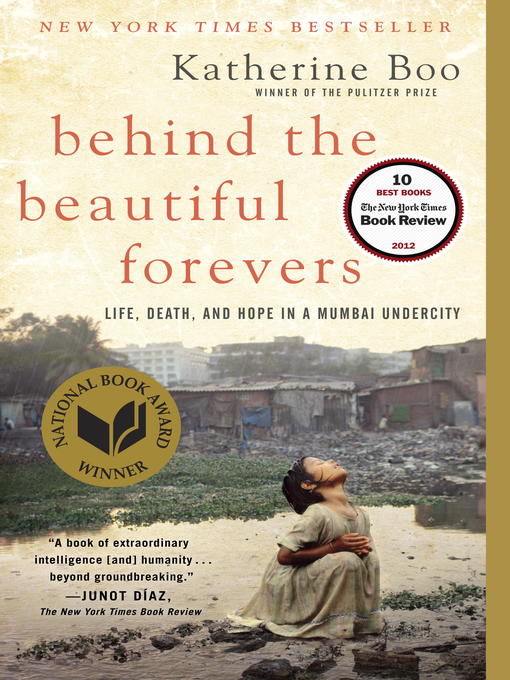
Behind the Beautiful Forevers
Life, death, and hope in a Mumbai undercity
فرمت کتاب
ebook
تاریخ انتشار
2012
Lexile Score
1030
Reading Level
6-8
ATOS
7.8
Interest Level
9-12(UG)
نویسنده
Katherine Booشابک
9780679643951
کتاب های مرتبط
- اطلاعات
- نقد و بررسی
- دیدگاه کاربران
نقد و بررسی

Starred review from October 17, 2011
A Mumbai slum offers rare insight into the lives and socioeconomic and political realities for some of the disadvantaged riding the coattails (or not) of India’s economic miracle in this deeply researched and brilliantly written account by New Yorker writer and Pulitzer Prize–winning journalist Boo. Divided into four parts, the narrative brings vividly to the page life as it is led today in Annawadi, a squalid and overcrowded migrant settlement of some 3,000 people squatting since 1991 on a half-acre of land owned by the Sahar International Airport. (Boo derives her title from a richly ironic real-world image: a brightly colored ad for floor tiles repeating “Beautiful Forever” across a wall shutting out Annawadi from the view of travelers leaving the airport.) Among her subjects is the fascinating Abdul, a sensitive and cautiously hopeful Muslim teenager tirelessly trading in the trash paid for by recycling firms. Crucially, Boo’s commanding ability to convey an interior world comes balanced by concern for the structural realities of India’s economic liberalization (begun the same year as Annawadi’s settlement), and her account excels at integrating the party politics and policy strategies behind eruptions of deep-seated religious, caste, and gender divides. Boo’s rigorous inquiry and transcendent prose leave an indelible impression of human beings behind the shibboleths of the New India.

Starred review from December 1, 2011
In her debut, Pulitzer Prize–winning New Yorker staff writer Boo creates an intimate, unforgettable portrait of India's urban poor. Mumbai's sparkling new airport and surrounding luxury hotels welcome visitors to the globalized, privatized, competitive India. Across the highway, on top of tons of garbage and next to a vast pool of sewage, lies the slum of Annawadi, one of many such places that house the millions of poor of Mumbai. For more than three years, Boo lived among and learned from the residents, observing their struggles and quarrels, listening to their dreams and despair, recording it all. She came away with a detailed portrait of individuals daring to aspire but too often denied a chance--their lives viewed as an embarrassment to the modernized wealthy. The author poignantly details these many lives: Abdul, a quiet buyer of recyclable trash who wished for nothing more than what he had; Zehrunisa, Abdul's mother, a Muslim matriarch among hostile Hindu neighbors; Asha, the ambitious slum leader who used her connections and body in a vain attempt to escape from Annawadi; Manju, her beautiful, intelligent daughter whose hopes laid in the new India of opportunity; Sunil, the master scavenger, a little boy who would not grow; Meena, who drank rat poison rather than become a teenage bride in a remote village; Kalu, the charming garbage thief who was murdered and left by the side of the road. Boo brilliantly brings to life the residents of Annawadi, allowing the reader to know them and admire the fierce intelligence that allows them to survive in a world not made for them. The best book yet written on India in the throes of a brutal transition.
(COPYRIGHT (2011) KIRKUS REVIEWS/NIELSEN BUSINESS MEDIA, INC. ALL RIGHTS RESERVED.)

September 15, 2011
You'll know Boo from her work at the Washington Post and now as staff writer for The New Yorker, which has brought her any number of honors, including the MacArthur "genius" award. Her writing is marked by a persuasive sense of humanity, never more than in this study of the hopeful and go-getting inhabitants of the slums surrounding the luxury hotels at the Mumbai airport. Teenaged Abdul aims to better his family with finds from the trash rich tourists have discarded, for instance, while Asha works to make her promising daughter the slum's first female college graduate. Of course, abuse, envy, and political and religious tensions turn up as well. Comparisons to Slumdog Millionaire are inevitable, but this would also match up nicely with fiction from Aravind Adiga (e.g., The White Tiger). For all informed readers; with a seven-city tour.
Copyright 2011 Library Journal, LLC Used with permission.

January 1, 2012
While the distance between rich and poor is growing in the U.S., the gap between the haves and have-nots in India is staggering to behold. This first book by a New Yorker staff writer (and Pulitzer Prizewinning reporter for the Washington Post) jolts the reader's consciousness with the opposing realities of poverty and wealth in a searing visit to the Annawaldi settlement, a flimflam slum that has recently sprung up in the western suburbs of the gigantic city of Mumbai, perched tentatively along the modern highway leading to the airport and almost within a stone's throw of new, luxurious hotels. We first meet Abdul, whose daily grind is to collect trash and sell it; in doing so, he has lifted his large family above subsistence. Boo takes us all around the community, introducing us to a slew of disadvantaged individuals who, nevertheless, draw on their inner strength to not only face the dreary day but also ponder a day to come that will, perhaps, be a little brighter. Sympathetic yet objective and eloquently rendered.(Reprinted with permission of Booklist, copyright 2012, American Library Association.)

























دیدگاه کاربران